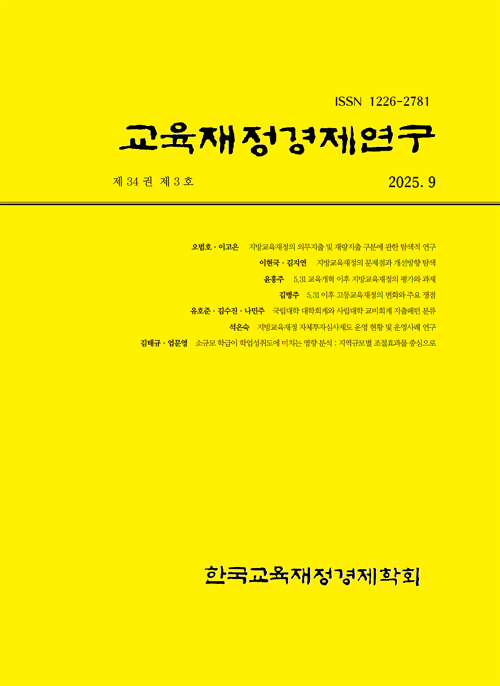- 영문명
- An Evaluation and Challenges of Local Education Finance Since the 5.31 Education Reform
- 발행기관
- 한국교육재정경제학회
- 저자명
- 윤홍주(Hongju Yun)
- 간행물 정보
- 『교육재정경제연구』제34권 제3호, 51~75쪽, 전체 25쪽
- 주제분류
- 사회과학 > 교육학
- 파일형태
- 발행일자
- 2025.09.30
5,800원
구매일시로부터 72시간 이내에 다운로드 가능합니다.
이 학술논문 정보는 (주)교보문고와 각 발행기관 사이에 저작물 이용 계약이 체결된 것으로, 교보문고를 통해 제공되고 있습니다.

국문 초록
본 연구는 5.31 교육개혁 30년을 맞아, 그동안의 지방교육재정의 변화를 살펴보고 그 성과, 쟁점과 과제를 제시하는 것을 목적으로 한다. 이를 위해 재원의 확보, 배분, 운영이라는 재정 활동 단계에 따라 안정성, 충분성, 공평성, 자율성, 효율성이라는 교육재정의 가치를 분석의 틀로 설정하였다.
분석 결과, 5.31 교육개혁 이후 지방교육재정은 내국세 연동 방식에 힘입어 학생 1인당 공교육비 등 양적 측면에서 상당한 성과를 거두었다. 그러나 지방교육재정의 운용 원리에 비춰볼 때, 해결해야 할 쟁점과 과제도 상당하다. 첫째, 안정성 측면에서는 법적 기반에도 불구하고 정부의 부정확한 세수 예측과 경직적인 정산 제도로 인해 연도별 재원 규모가 급등락하는 실질적 불안정성이 심화되었다. 둘째, 충분성 측면에서는 거시 지표의 양호함에도 불구하고, 실제 교육 수요가 아닌 확보된 재원에 지출을 맞추는 양입제출(量入制出)의 구조적 한계와 단위학교까지 재원이 충분히 전달되지 않는 문제가 있었다. 셋째, 공평성 측면에서는 지역 간 수평적 공평성은 높았으나, 교육 소외계층 등 다양한 필요를 반영하는 수직적 공평성은 미흡한 것으로 나타났다. 넷째, 자율성 측면에서는 총액배분 원칙에 맞지 않은 과도한 측정항목으로 지방교육자치의 이념을 저해하는 문제가 있었다. 마지막으로 효율성 측면에서는 과도한 이·불용액 및 기금 규모에 대한 외부의 비판, 유·초·중등교육과 고등교육 간 재정 불균형 문제도 향후 지방교육재정이 해결해야 할 과제임을 확인하였다.
영문 초록
The purpose of this article, marking the 30th anniversary of the 5.31 Education Reform, aims to historically review the changes in local education finance over the past three decades and to provide a multi-faceted diagnosis of its outcomes and challenges. For this purpose, the study employs an analytical framework based on five core values of education finance—stability, adequacy, equity, autonomy, and efficiency—applied across the fiscal stages of revenue generation, allocation, and operation.
The analysis reveals that since the 5.31 Education Reform, local education finance has achieved remarkable quantitative growth, such as in per-student public expenditure, driven by the system linking its funding to a fixed percentage of national tax revenue. However, an evaluation based on the core principles of its operation reveals significant challenges. First, in terms of stability, despite its legal foundation, the system's actual stability has been undermined by inaccurate government tax revenue forecasts and a rigid settlement system, leading to severe annual fluctuations in funding. Second, regarding adequacy, while macro-level indicators appear favorable, there are structural limitations stemming from the practice of 'spending based on revenue', rather than actual educational needs, and issues with funds not being sufficiently delivered to the school level. Third, in terms of equity, while a high level of horizontal equity among regions has been achieved, vertical equity, which considers the diverse needs of disadvantaged students, remains insufficient. Fourth, concerning autonomy, the principle of lump-sum allocation has been weakened by an excessive number of budget measurement items, eroding the ideal of local educational autonomy. Finally, regarding efficiency, external debates over excessive unused funds and reserves, along with the fiscal imbalance between K-12 and higher education, were identified as critical challenges for the future.
목차
Ⅰ. 서론
Ⅱ. 지방교육재정 제도 및 규모의 변화
Ⅲ. 지방교육재정 운용에 대한 평가 및 쟁점
Ⅳ. 결론
참고문헌
키워드
해당간행물 수록 논문
참고문헌
교보eBook 첫 방문을 환영 합니다!

신규가입 혜택 지급이 완료 되었습니다.
바로 사용 가능한 교보e캐시 1,000원 (유효기간 7일)
지금 바로 교보eBook의 다양한 콘텐츠를 이용해 보세요!



